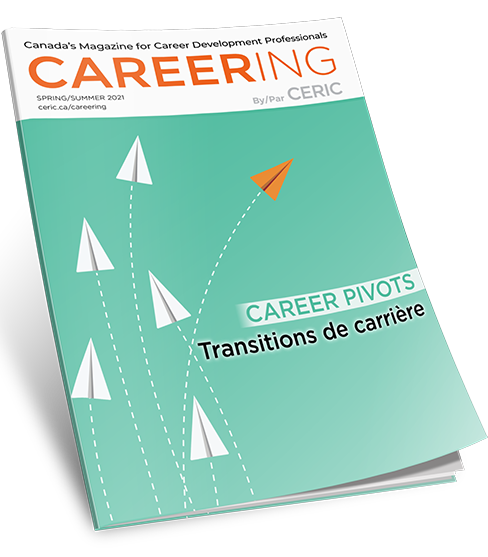L’intersection de la diversitè et de l’inclusion en milieu de travail (en anglais)
Dernière mise à jour : octobre 2017
Aghazadeh, S-M. (2004). Managing workforce diversity as an essential resource for improving organizational performance. Journal of Productivity and Performance Management, 53(6).
Albert, R.T. (2017). Cultural Diversity in the Workplace, Part 1. Diversity Resources.
Ashikali, T. & Groeneveld, S. (2015). Diversity management in public organizations and its effect of employees’ affective commitment: The role of transformational leadership and the inclusiveness of the organizational culture. Review of Public Personnel Administration, 35(2), 146-168.
Austin, L. (2010). Framing Diversity: A qualitative content analysis of public relations industry publications. Public Relations Review, 36(3), 298-301.
Babcock, P. (2009). Diversity Accountability Requires More Than Numbers. SHRM.
Berry, P. (2013). Four Ways to Reinvigo. Diversity Executive.
Bersin, J. (2015). Why Diversity and Inclusion Will Be a Top Priority for 2016. Forbes
Birkett, H., Duberley, J. (2017). Britain and Beyond: Why Diversity and Inclusion at Work Matters. Birmingham Business Blog.
Bourke, J., Garr, S., van Berkel, A., Wong, J. (2017). Diversity and inclusion: The reality. Deloitte Insights.
Bourke, J. Smith, C., Stockton, H., Wakefield, N. (2014). From diversity to inclusion. Move from compliance to diversity as a business strategy. Deloitte Insights.
Brenman, M. (2014). Diversity Metrics, Measurement, and Evaluation. Workforce Diversity Network.
Brooks, K. (2017). At the Intersection: Discrimination and Diversity in the Modern Workplace. DS News.
Carter, E. (2017). Workforce Diversity – A Journey Through Inclusion and Diversity in the Workforce. American Water Works Association.
Carter-Hicks, G. (2015). The Intersection of Diversity, Inclusion, Maslow’s Theory & Engagement. LinkedIn.
Chesler, N.C., Barabino, G., Bhatia, S.N., & Richards-Kortum, R. (2010). The pipeline still leaks and more than you think: A status report on gender diversity in biomedical engineering. Annals of Biomedical Engineering, 38, 1928-1935.
Church, A.H., & Rotolo, C.T. 92013). Leading diversity and inclusion efforts in organizations: Should we be standing behind our data or our values (or both)? Industrial Psychology, 6(3), 245-248.
Clark, L. (2015). FAST FACTS: Diversity and Inclusion Around the World. Diversity Best Practices.
Cunningham, D.D., Green, D.D. (2007). Diversity as a Competitive Strategy in the Workplace. Journal of Practical Consulting, Vol. 1, Iss. 2, pp. 51-55.
Curry, M. (2016). Diversity: No Longer Just Black and White. Business Training Media.
Deane, B.R., Ferdman, B.M. (2013). Diversity at Work: The Practice of Inclusion. Jossey-Bass.
Derven, M. (2016). The Intersection of Innovation, Inclusion, and Diversity. Human Capital Blog.
Derven, M. (2013). Diversity & Inclusion: Making the Business Case. Human Capital Blog.
Derven, M. (2013). Measure Diversity & Inclusion for Maximum Impact. Human Capital Blog.
Derven, M. (2013). Leverage D & I to Deliver to the Marketplace and Improve the Workplace. Human Capital Blog.
Dickey, M.R. (2016). A look back on tech diversity and inclusion in 2016. Tech Crunch
Dishman, L. (2015). Millennials Have a Different Definition of Diversity and Inclusion. FastCompany
Dizikes, P. (2014). Study: Workplace diversity can help the bottom line. MIT News
Donius, B. (2009). The Workplace: Culture of Inclusion vs. Culture of Exclusion: What is the Impact? The Blog.
Donnelly, G. (2017). Survey Confirms What Diversity Professionals Have Long Suspected: People Think Inclusion in the Workplace Hurts White Me. Fortune.
Dupree, D. (2017). Diversity & Inclusion Activities. Career Trend.
Dyson, M.A. (2017). The Values of Workplace Diversity and Inclusion. The Voice of Job Seekers.
Egan, M.E. (2016). Fostering Innovation Through a Diverse Workforce. Forbes Insights.
Ely, R.J., Thomas, D.A. (2001). Cultural Diversity at Work: The Effects of Diversity Perspectives on Work Group Processes and Outcomes. Administrative Science Quarterly, Vol. 46, No. 2, pp. 229-273.
Espinoza-Madrigal, I. (2012). Sexual Orientation, Gender Identity, and Diversity in the Workplace. The Practical Lawyer.
Ewoh, A.I.E. (2013). Managing and valuing diversity: Challenges to public managers in the 21st Century. Public Personnel Management, 42, 2, 107-122.
Fallon, N. (2017). A Culture of Inclusion: Promoting Workplace Diversity and Belonging. Business News Daily.
Farndale, E., Biron, M., Briscoe, D.R., & Raghuram, S. (2015). A global perspective on diversity and inclusion in work organizations. The International Journal of Human Resource Management. Volume 26, Issue 6.
Felleke, H. (2014). The Intersection of Diversity and Innovation – What’s Your Story. U.S. Chamber of Commerce Foundation.
Frierson, W. (2015). What’s the Difference Between Diversity and Inclusion? College Recruiter.
Gallicano, T.D. (2013). Millennials’ perceptions about diversity in their PR agencies. Public Relations Journal, 7(2), 37-70.
Gaudiano, P., Hunt, E. (2017 ). Nine leadership lessons from ‘Hidden Figures’ about workplace diversity and inclusion. Bloomberg.
Gerstandt, J. (2017). Considering the intersection of inclusion and talent: Being Competitive for Talent Means Being Serious about Inclusion. Future of Talent Institute.
Green, K., Lopez, M., Wysocki, A., Kepner, K., Farnsworth, D., and Clark, J.L. (2017). Diversity in the Workplace: Benefits, Challenges, and the Required Managerial Tools. University of Florida.
Greenberg, J. (2017). Diversity in the Workplace: Benefits, Challenges and Solutions. Monster.
Haug, J. (2013). The ‘Diversity’ Movement: Defeating Itself, Destroying Society. American Thinker.
Hicks-Clarke, D., & Iles, P. (2000). Climate for diversity and its effects on career and organizational attitudes and perceptions. Personnel Review, 29(3), 324-345.
Hudson Jordan, T. (2016). Moving from Diversity to Inclusion. Diversity Journal.
Irwin, E. (2017 ). Diversity and inclusion: Stop talking and do your homework. Open Source.
Johansson, A. (2017). How Millennials Separate Diversity from Inclusion – And Why That Matters. Forbes.
Johansson, A. (2017). Why Workplace Diversity Diminishes Groupthink and How Millennials Are Helping. Forbes.
Kelly, W.S., Smith, C. (2013). What if the road to inclusion were really an intersection. Deloitte University Press.
Kenely, N. (2013). The importance of training in diversity management. Times of Malta
Johnsen, J., Gallivan, White & Boyd, P.A. (2015). 5 Strategies for Promoting Diversity in the Workplace. GWB Law Firm.
McCord, K. (2016). Equity, Diversity, and Inclusion in the Arts: It is Possible. AlternateRoots.
McCormick, K. (2007). The Evolution of Workplace Diversity. State Bar of Texas.
McDowell, J. (2017). Corporate Diversity Should Mirror Both Population and Customer. Recruiter Today.
McDowell, J. (2017). Cultivating Innovation in the Workforce Through Diversity. Recruiter Today.
McDowell, J. (2017). Today’s Students Are Counting on Tomorrow’s Workplace Diversity. Recruiter Today.
Medina, S. (2014). Why You Should Do More Than Just Talk About Workplace Diversity. FastCompany.
Moulesong, B. (2012 ). The success of diversity and inclusion in the workplace starts with the top management. Times.
Nally, D. (2015). Five reasons why diversity and inclusion matter to every business – and every employee. CEO Insights.
Napolitano, A. (2017). Workplace Diversity Doesn’t Happen by Accident. Recruiter Today.
Nilson, K. (2015). Dispelling 4 myths that shroud diversity and inclusion. Journal of Accountancy.
O’Brien, J. (2014). The Diversity Equation: How Inclusiveness is Driving Workplace Engagement. American Express
Oliha, H., & Collier, M.J. (2010). Bridging diverse standpoints and ideologies : Organizational initiatives and training. The International Journal of Diversity in Organizations, Communities and Nations. 10(4), 61-74.
Ozbilgin, M.F. (Editor) (2009). Equality, Diversity and Inclusion at Work. A Research Companion. Elgar.
Peckham Nordquist, E. (2014). Diversity and Inclusion: An Analysis of the Best Companies to Work for and Fortune 100 Companies’ Websites. All Theses and Dissertations. 4017.
Perez, K. (2015 ). 3 Ways to Empower Employees to Promote Diversity in the Workplace. Wilson HCG.
Pless, N.M., and Maak, T. (2004). Building an Inclusive Diversity Culture: Principles, Processes and Practice. Journal of Business Ethics, Vol. 54, No. 2, pp. 129-147.
Ponciano, L., Shabazian, A. (2012). Interculturalism: Addressing Diversity in Early Childhood. Dimensions of Early Childhood. Vol. 40, No. 1.
Rider University. (n.d.) Using Inclusive Language: Guidelines and Examples.
Robertson, Q.M. (2004). Disentangling the Meanings of Diversity and Inclusion. Cornell University.
Ruggs, E., Hebl, M., (2012). Literature Overview: Diversity, Inclusion, and Cultural Awareness for Classroom and Outreach Education. AWE.
Sha, B-L. (2013). Diversity in public relations. PR Journal, 7(2), 1-7.
Shahriari, S., & Eisterhold, C. (2015). Intersection – Inclusion and Diversity at MU. KBIA.
Shen, J., Chanda, A., D’Netto, B., and Monga, M. (2009). Managing diversity through human resource management: an international perspective and conceptual framework. The International Journal of Human Resource Management, Vol. 20. No. 2, 235-251.
Shin, H.Y., Park, H.J. (2013). What are the Key Factors in Managing Diversity and Inclusion Successfully in Large International Organizations? Cornell University.
Sidberry, T. (2015). Achieving Diversity in the Nonprofit Workplace: A Step-by-Step Guide. TSNE MissionWorks.
Smedley, T. (2014). Equality in workplace. The Evidence is growing – there really is a business case for diversity. Financial Times.
Srinivasan, L. (2011). 5 steps to gender inclusivity at workplace. My bangalore.
Stevens, F.G., Plaut, V.C., Sanchez-Burks, J. (2008). Unlocking the Benefits of Diversity. The Journal of Applied Behavioral Science, Vol. 44 No. 1`, 116-133.
Stokes, L. (2012). Animals, Salads, Orchestras, Houses – oh my! Diversity Executive.
Thompson, S. (2017). Equality & Diversity in the Workplace. Chron.
Turner, T. (2014). Winning at the Intersection of Equity, Diversity & Inclusion. Turner Consulting Group.
Vardeman-Winter, J., Place, K. (2017). Still a lily-white field of women: The state of workforce diversity in public relations practice and research. Public Relations Review, 43, 326-336.
Weaver, V.J. (2016). Is There a Downside to Inclusion. Diversity Best Practices.
Wedgwood, C. (2017). Making the Case for Diversity, Equality and Inclusion. New Schools Venture Fund.
Welsh, S. (2017). Leadership summit to discuss diversity, inclusion in the workplace. Crain’s Detroit Business.
Wentling, R.M. (2014). Diversity Initiatives in the Workplace. Work in Progress at the University of Illinois. University of Illinois.
Williams, C. (2017). Tim Cook discusses diversity, inclusion with students. Auburn, Ala.
Yang, Y., & Konrad, A.M. (2011). Diversity and organizational innovation: The role of employee involvement. Journal of Organizational Behavior. 32(8). 1062-1083.







